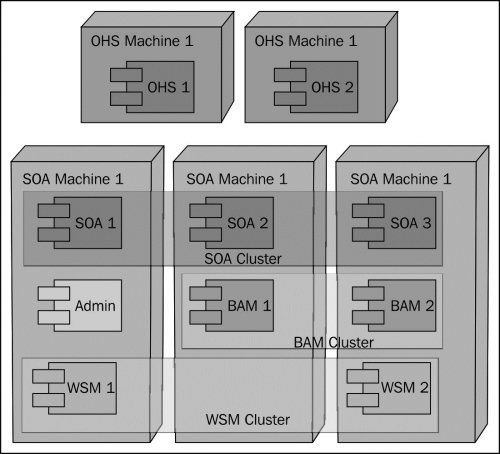Before starting to build an SOA Suite cluster it is important to ensure that you have all the required configuration information and the environment is prepared correctly. Time spent doing this properly will save a lot of heartache and delay later.
Make sure you know how big a cluster you wish to build in terms of number of managed servers.
- Create a drawing of the topology.
Before starting, make sure you understand the topology of the cluster you wish to build and draw a picture of it either on a whiteboard or using a drawing tool such as Visio.

- Identify physical machines for web servers.
Get the names of the physical servers that will be running the web servers and fill them in on a list similar to the one shown as follows. Also identify the port number that the web server will be running on and the protocol that it will be using.
- Identify physical machines for WebLogic servers.
Get the names of the physical servers that will be running SOA Suite and fill them in on a worksheet similar to the one shown as follows. Use the WebLogic Servers column to identify which servers will normally run on the physical machine, ignore fail over for now.
- Identify port numbers for WebLogic servers.
Create a table identifying the port number to be used for each type of server in your cluster similar to the one as follows:
The previous table shows the suggested values from the EDG.
- Identify floating IP addresses for WebLogic servers.
Create a table identifying the virtual, or floating, IP addresses to be used for each server that requires whole server migration similar to the one shown as follows:
The topology drawing and the list of physical machines for WebLogic and web servers will help the team provisioning the hardware to understand what physical or virtual machines must be provided and how they are connected.
The list of web server machine names, WebLogic server machine names, and port numbers can be provided to the network team who will use it in conjunction with the topology diagram to configure the firewall. They will also use it to create server pools in the load balancer for each protocol type and then add the web servers to the newly created pools.
The list of WebLogic server floating IP addresses can be used by the network team to allocate suitable IP addresses and, when coupled with the port numbers for WebLogic servers can be used to identify ports that must be opened in any firewalls between the web servers, and the WebLogic servers.
When running the domain wizard, the names of the managed servers and their associated floating IP addresses and port numbers will be required.
The Admin server is treated differently from managed servers because the Admin server does not share its shared filesystem with other WebLogic instances. A failover script can be used to unmount and mount shared storage for the Admin server as part of the failover task.
If the web servers will be running multiple protocols then you can use multiple lines for a single web server machine.
|
Web server port number |
Protocol | |
|---|---|---|
|
WebMachine1 |
|
HTTP |
|
WebMachine1 |
|
HTTPS |
|
WebMachine2 |
|
HTTP |
|
WebMachine2 |
|
HTTPS |
Tip
Downloading the example code
You can download the example code files for all Packt books you have purchased from your account at http://www. packtpub.com. If you purchased this book elsewhere, you can visit http://www.packtpub.com/support and register to have the files e-mailed directly to you. The code package for the book includes an Excel workbook SOA-Cookbook-Cluster-Workbook.xls with worksheets containing templates for the tables used in this recipe.
